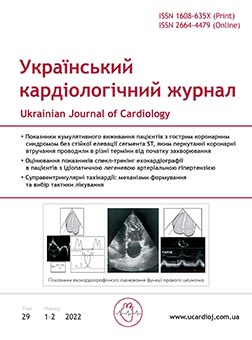Evaluation of specle-traking echocardiography indicators in patients with idiopathic pulmonary arterial hypertension
Main Article Content
Abstract
The aim – to evaluate the diagnostic possibilities of using the method of speckle-tracking echocardiography (ST-Echo) in patients with idiopathic pulmonary arterial hypertension (IPAH) and to compare the results with a healthy population.
Materials and methods. The study included 27 patients with IPAH and 9 people who were in the control group. Both groups were comparable in age and sex. All patients underwent general clinical studies, biochemical blood tests to determine the level of N-terminal polypeptide of brain natriuretic hormone (NT-proBNP), 6-minute walk test, transthoracic and speckle-tracking echocardiography, Cardio-ankle vascular index (CAVI), right heart catheterization (RHC) using a Swan–Gantz catheter to determine central hemodynamic parameters.
Results and discussion. According to echocardiography, in patients with IPAH, TAPSE, FAC, RIMP and S‘ of the right ventricle were significantly worse than in the control group, and the rates of global longitudinal strain of the right (RV GLS) and left ventricles (LV GLS) and longitudinal strain rate of the right ventricle (RV GLSR). Using correlation analysis, it was found that the RV GLS was most strongly correlated, among others, with the distance (p<0.001) and blood oxygen saturation (p<0.05) according to the 6-minute walk test, NT-proBNP (p<0.001), systolic pulmonary artery pressure according to echocardiography (p<0.001) and CAVI (p<0.001). In contrast, the highest correlation with direct hemodynamic measurements was shown by two parameters: TAPSE – with cardiac index (p<0.05), pulmonary vascular resistance (PVR) (p<0.05), diastolic pressure in the pulmonary artery (p<0.05); and RIMP – with diastolic pulmonary artery pressure (p<0.001) and mean pulmonary artery pressure (p<0.05).
Conclusions. According to our results, we can conclude that a comprehensive assessment of RV function using transthoracic and ST-echocardiography allows a more individualized assessment of patients with IPAH. ST-Echo can be used in PH reference centers for initial examination and follow-up of such patients. ST-Echo is a complex and time-consuming study, so our data did not demonstrate the feasibility of using this technique in routine practice for the initial assessment of patients with suspected IPAH.
Article Details
Keywords:
References
Galie N, Humbert M, Vachiery JL, et al. 2015 ESC/ERS Guidelines for the diagnosis and treatment of pulmonary hypertension: The Joint Task Force for the Diagnosis and Treatment of Pulmonary Hypertension of the European Society of Cardiology (ESC) and the European Respiratory Society (ERS): Endorsed by: Association for European Pediatric and Congenital Cardiology (AEPC), International Society for Heart and Lung Transplantation (ISHLT). Eur Respir J. 2015.;46:903–75. doi: https://doi.org/10.1183/13993003.51032-2015.
Vonk Noordegraaf A, Chin KM, Haddad F, et al. Pathophysiology of the right ventricle and of the pulmonary circulation in pulmonary hypertension: an update. Eur Respir J. 2019;24(53). doi: https://doi.org/10.1183/13993003.01900-2018.
Rosenkranz S, Howard LS, Hoeper MM, et al. Systemic consequences of pulmonary hypertension and right-sided heart failure. Circulation. 2020;141:678–93. doi: https://doi.org/10.1161/CIRCULATIONAHA.116.022362
Vonk-Noordegraaf A, Haddad F, Chin KM, et al. Right heart adaptation to pulmonary arterial hypertension: physiology and pathobiology. J Am Coll Cardiol. 24(62):22–33. doi: https://doi.org/10.1016/j.jacc.2013.10.027.
Prieto O, Cianciulli TF, Stewart-Harris A, et al. Speckle tracking imaging in patients with pulmonary hypertension. J Cardiovasc Imaging. 2021;29(3):236–51. doi: https://doi.org/0.4250/jcvi.2020.0192
Ferrara F, Zhou X, Gargani L, et al. Echocardiography in Pulmonary Arterial Hypertension. Curr Cardiol Rep. 2019;4 (21). doi: https://doi.org/10.1007/s11886-019-1109-9.
Гіреш Й.Й. Оцінювання гендерних особливостей систолічної та діастолічної функції серця при гіпертонічній хворобі методом спекл-трекінг ехокардіографії. Укр. кардіол. журн. 2017. № 2. C. 63–67. http://ucardioj.com.ua/index.php/UJC/article/view/149
Несукай О.Г., Гіреш Й.Й. Динаміка показників деформації лівих відділів серця у хворих на гіпертонічну хворобу при довготривалому лікуванн. Укр. кардіол. журн. 2017. № 6. C. 89–95. http://ucardioj.com.ua/index.php/UJC/article/view/105
Коваленко В.М., Несукай О.Г., Даниленко О.О., Поленова Н.С., Тітов Є.Ю. Геометрія скорочення лівого шлуночка – новий погляд на проблему через призму структурної організації міокарда. Укр. мед. часоп. 2013. № 2 (94). С. 183–187.
Живило І.О., Радченко Г.Д., Тітов Є.Ю., Сіренко Ю.М. Структурно-функціональний стан артерій великого кола кровообігу в пацієнтів з ідіопатичною легеневою артеріальною гіпертензією з різними функціональними можливостями та кінцевими точками. Укр. кардіол. журн. 2017. № 5. С. 24–30. http://ucardioj.com.ua/index.php/UJC/article/view/109
Живило І.О. Структурно-функціональний стан артерій великого кола кровообігу в пацієнтів із легеневою артеріальною гіпертензією. Артеріальна гіпертензія. 2017. № 3. С. 75–76. http://www.mif-ua.com/archive/article/44843
Modin D, Møgelvang R, Andersen DM, et al. Right ventricular function evaluated by tricuspid annular plane systolic excursion predicts cardiovascular death in the general population. J Amer Heart Assoc. 2019;21;8(10):e.012197. doi: https://doi.org/10.1161/JAHA.119.0121972019;8:e012197
Almeida AR, Loureiro MJ, Lopes L, et al. Echocardiographic assessment of right ventricular contractile reserve in patients with pulmonary hypertension. Revista Portuguesa de Cardiologia. 2014;33(3):155–63. doi: https://doi.org/10.1016/j.repce.2013.09.017.
Frost A, Badesch D, Gibbs JSR, et al. Diagnosis of pulmonary hypertension. Eur Respir J. 2019;53:1801904. doi: https://doi.org/10.1183/13993003.01904-2018.

